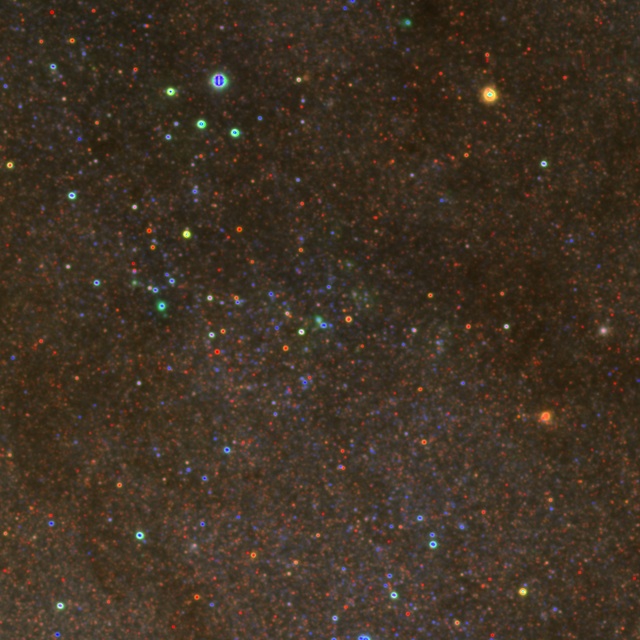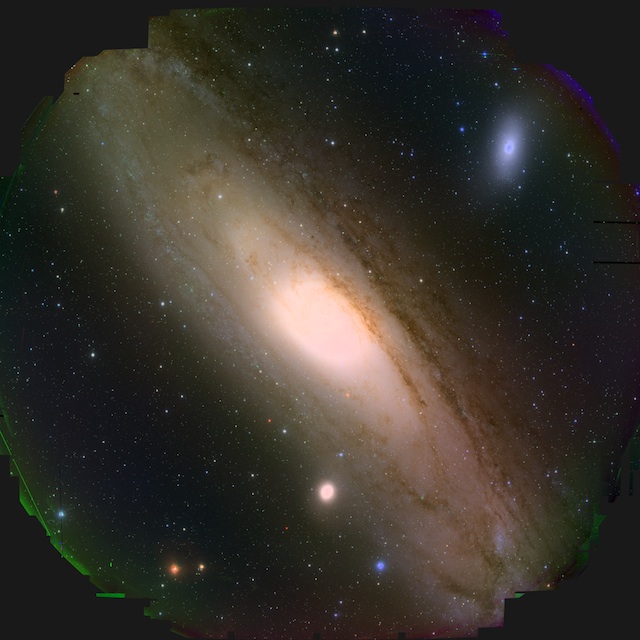Subaru Telescope's M31 Image Processed by the HSC Data Analysis Software
(Originally published by Kavli IPMU)
August 6, 2013
Today, researchers at the Kavli Institute for the Physics and Mathematics of the Universe (Kavli IPMU) released the first image of the Andromeda Galaxy (M31) processed with the data analysis software developed for the Subaru Telescope's Hyper Suprime-Cam (HSC). The HSC project's `first light' was announced last week (A New View on the Origin of Dark Matter and Dark Energy - Image of M31 Heralds the Dawn of HSC -). Researchers at the Kavli IPMU have collaborated with Princeton University and the National Astronomical Observatory of Japan (NAOJ) to develop the HSC data analysis pipeline. The sharp images of stars over such a wide field of view demonstrates the HSC's outstanding power. Such image quality will be indispensable for researchers hoping to reveal the nature of dark matter and dark energy in the universe.

The M31 image shown was made with data taken by the HSC camera mounted on the Subaru Telescope, and was constructed using the HSC data analysis pipeline. The exposure times for g, r, and i-bands were 10, 12, and 16 minutes, respectively; and these three colors have been allocated to blue, green, and red to make the color image. In some places, extremely bright sources of light cause the CCD device to become saturated. This often occurs in the centers of bright stars and galaxies, and causes the color to appear strange. For scientific research, such areas are carefully avoided. The central region of the galaxy shown is widely saturated, but has been artificially corrected to produce the attractive color image.
Naoki Yasuda, Professor at the Kavli IPMU, who plays a key role on the HSC data processing, said, "There is no doubt that HSC is the finest wide field, high resolution camera in the world. In order to accelerate scientific research, however, the data taken by HSC have to be handled adequately and the maximum amount of information contained in the data has to be extracted as soon as possible. To realize this requirement, we have been developing the HSC data analysis pipeline. Today we have confirmed the performance of our pipeline software using data from HSC's first light observations. We're very pleased with the results, but we will continue to tune-up the software more before the survey observations are underway, and while the survey progresses."

Funding for the HSC Project was provided in part by the following grants: Grant-in-Aid for Scientific Research (ID 15340065) to S. Miyazaki (NAOJ); Grant-in-Aid for Scientific Research on Priority Areas (ID 18072003) to H. Karoji (first at NAOJ, then at Kavli IPMU); and the Funding Program for World-Leading Innovative R&D on Science and Technology (FIRST) entitled, "Uncovering the Origin and Future of the Universe-ultra-wide-field imaging and spectroscopy reveal the nature of dark matter and dark energy" to H. Murayama (Kavli IPMU).
The Kavli Institute for the Physics and Mathematics of the Universe (Kavli IPMU) is an international research institute with English as its official language. The goal of the institute is to discover the fundamental laws of nature and to understand the universe from the synergistic perspectives of mathematics, astronomy, and theoretical and experimental physics. The Institute for the Physics and Mathematics of the Universe (IPMU) is established in October 2007 as one of the World Premier International Research Center Initiative (WPI) of the Ministry of Education, Sports, Science and Technology in Japan with the University of Tokyo as the host institution. IPMU was designated as the first research institute within Todai Institutes for Advanced Study (TODIAS) in January 2011. It received endowment from The Kavli Foundation and was renamed “Kavli Institute for the Physics and Mathematics of the Universe” in April 2012. Kavli IPMU is located on the Kashiwa campus of the University of Tokyo, and more than half of its full-time scientific members come from outside Japan.